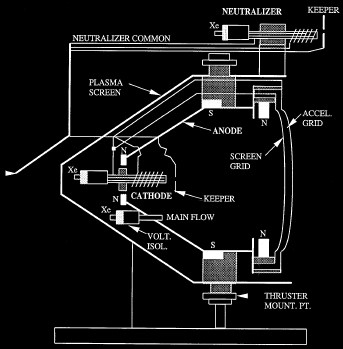
http://www.nasa.gov/missions/historical
| home:physical model:DS1 Simulation | sitemap |
|
DS1 Simulation |
 http://www.nasa.gov/missions/historical |
The Deep Space 1 satellite, launched in October of 1998, served as a test platform for a number of new technologies. Among them was the use of an electric thruster as the primary method of propulsion. The thruster developed for this mission was named NSTAR, standing for NASA Solar Electric Propulsion Technology Application Readiness. It was 30 cm in diameter, and operated with 0.5 to 2.3 kW of input power to generate thrust from 19 mN to 92 mN at specific impulse ranging from 1900 to 3100 s. The dry mass of the thruster and the support systems was about 28 kg. Another 20 kg was used to store the xenon propellant, which itself had a mass of about 82 kg. |
|
The NSTAR Thruster used the principles of ion propulsion to generate thrust.
An ion engine consist of a discharge chamber, the ion optics and a neutralizing cathode. The propellant, usually an inert gas, such as
Xenon in the case of NSTAR is fed into the discharge chamber, where it collides with electrons released from the ionization cathode. The Xenon ions are
then diverted through the accelerator grid out of the thruster. Electrons are injected into the positive flow from the neutralizing cathode
to maintain a space charge neutrality.
The plume velocities achieved with an ion thruster are usually on the order of magnitude higher than those available from chemical boosters. This characteristic feature of ion propulsion is very attractive to the mission designers, since higher exit velocities (and thus higher specific impulse) mean that the thruster is more efficient. As such, less propellant needs to be carried. An ion engine will typically need only 1/10 the propellant needed by a chemical booster to achieve the same change in velocity. Unfortunately, the thrust generated by ion engines is very small, and thus they are suitable only for long duration interplanetary missions, or station keeping. Ion engines do not produce enough thrust to overcome the gravitational forces, and chemical boosters are needed to launch the spacecraft into orbit. |
 Hughes Electron Dynamics |
Ion engines suffer from another problem. The ionization inside the discharge chamber is not perfect and it is possible for neutral atoms to drift out of the thruster. These slow moving neutrals can then collide with the fast moving ions making up the plasma plume. If the collision energy is high enough, it is possible for a charge exchange (CEX) reaction to occur. This will result in a slow moving ion and a fast moving neutral. The slow moving charge exchange ions can then be attracted onto the aircraft. Since xenon is non-contaminating, the backflow of the CEX ions will primarily only affect the, if any, sensors sensitive to local space charge distribution. A more serious problem occurs when the CEX ions are attracted back to the accelerator. The collision can remove, or sputter off, some of the atoms making up the grid. Grid erosion is the primary factor limiting the useful lifetime of an ion thruster. Furthermore, the ion optics are usually manufactured from molybdenum, which is a contaminating specie. The sputtered off molybdenum particles can then backflow onto the satellite, where they will contaminate critical devices, such as the solar arrays or cameras.
The backflow of the CEX ions was simulated by Dr. Joseph Wang, and the results of his simulation serve as the data for this project. The simulation was performed on a model consisting of only 1/4 of the DS1 satellite; the entire volume was recreated by post-processing according to the symmetry. The simulation used a 43x43x71 grid with approximately 5 million particles. The grid discretization was set to approximately 6 cm, which roughly corresponded to the Debye length of the CEX ions. The simulation took about 5 CPU hours on a Cray SV1-1A supercomputer.